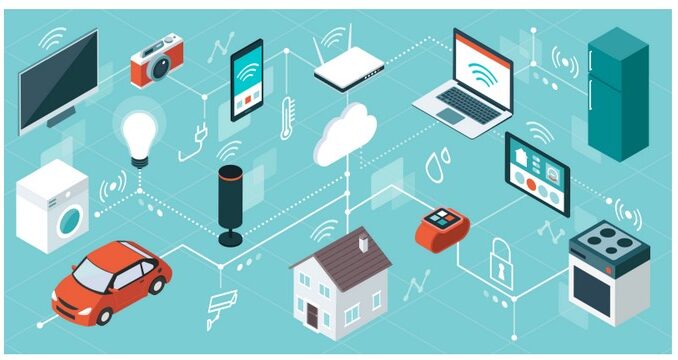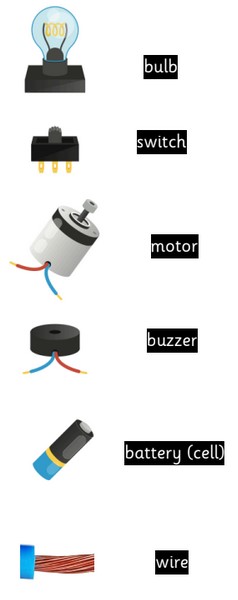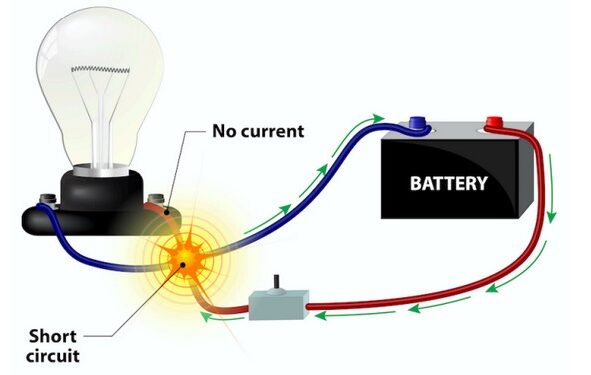Which appliances run on electricity?
Common appliances that use electricity are: toasters, lamps, kettles, laptops, games consoles, phones, torches, TVs, washing machines and irons.
Some appliances use batteries and some use mains electricity. Batteries can vary greatly in size, shape and power.

What are electrical conductors and insulators?
An electrical conductor lets electricity pass through it. They are often metal (e.g. iron, copper and gold) but also include carbon and water. As our bodies are 18% carbon, electricity is very dangerous to us and because water is a very good conductor of electricity we mustn’t use electrical appliances near it!

An insulator doesn’t let electricity pass through it, e.g. wood, leather and plastic. Plastic is used to cover electrical wires because it is a good insulator.

How does a circuit work?
In a series circuit all the components are joined together and the electricity can only flow in one direction You must learn the different symbols for the different components. Switches can be used to open and close circuits.


However, a circuit will not work properly if:
• the cells aren’t connected correctly (+ to – not ++ or – -)
• a component isn’t working or there’s no bulb;
• the circuit has gaps
• one of the components acts as an insulator.
Focus Scientist
Alessandro Volta (1745-1827) Italian physicist best known for the development of the voltaic pile (battery). SI unit of voltage, the volt is named after him.

Claire J Tomlin (b.1969) is a highly innovative electrical engineer who has born in Southampton and has worked at both the Universities of Berkeley and Stamford.

Key Vocabulary
electricity: a form of energy that can be carried by wires and is used for heating and lighting, and to provide power for devices.
bulb: the glass part of an electric lamp, which gives out light when electricity passes through it.
battery: a container of one or more cells in which chemical energy is converted into electrical energy and used as a source of power.
buzzer: an electrical device that is used to make a buzzing sound .
cells: a cell is a single unit used for converting chemical or solar energy into electricity.
circuit: a complete route which an electric current can flow around.
switch: a small control for an electrical device which you use to turn the device on or off.
wires: a long thin piece of metal that is used to fasten things or to carry electric current.
motor: a device that uses electricity or fuel to produce movement.
conductors: a substance that heat or electricity can pass through or along.
insulators: a non-conductor of electricity or heat.
electrical appliances: an electrical device or machine in your home that you use to do a job such as cleaning or cooking.
mains: where the supply of water, electricity, or gas enters a building.
component: the parts that something is made of.
current: a flow of electricity through a wire or circuit.
energy: the power from sources such as electricity that makes machines work or provides heat.
Electricity




Standard electrical appliances that use electricity.

Electronic icons

How electricity connects our appliances and devices across the home

What are the properties of materials that conduct electricity?
Materials Conduct Electricity

What are the properties of materials that insulate and don not conduct electricity?
Circuit components

OPEN and CLOSED simple series circuits

Electrical wires are used to conduct electricity around a circuit



Short circuit is when exposed wires touch and the circuit is cut short

The component (bulb) does not have an electrical current and cannot light up.
Electricity – Simple Circuits
Materials are either
Conductors
A conductor allows electricity to pass through it. E.g. metals are good conductors
or Insulators
An insulator does not allow electricty to pass through it. E.g. wood
A good conductor is a bad insulator.
A bad conductor is a good insulator.
To test whether a material is a conductor or an insulator you need to use a complete circuit.
